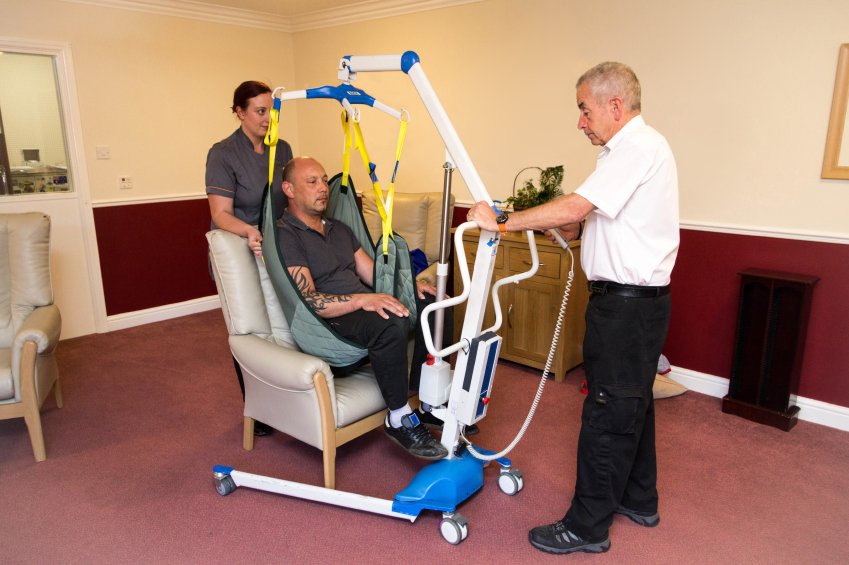Imagine this: you’re a carer starting your morning shift at an aged care facility. The kettle’s just boiled, your clipboard is ready, and your first task? Helping Mr. Thompson out of bed and into his wheelchair. He’s alert, cooperative, and eager to get to breakfast. But there’s a catch—his legs aren’t as strong as they used to be.
So, do you reach for a passive lifter or a standing hoist?
This is the kind of real-world decision carers make every day—and it’s far from simple. The choice between a standing hoist and a passive lifter can shape a patient’s comfort, independence, and even their recovery.
In this guide, we’ll walk you through the difference between the two, highlight when to use CHS Healthcare standing hoists, and help you make the right call for every situation.
The Two Titans of Transfer: A Quick Overview
Before we get into the nitty-gritty, let’s paint a picture of these two mobility heroes.
Standing Hoists – For When There’s Still a Spark
Think of standing hoists as supportive partners—perfect for those who can stand with help and just need a lift (literally and figuratively). Devices like CHS Healthcare standing hoists are designed to gently guide patients from sitting to standing positions, while encouraging them to use their muscles and stay involved.
They come equipped with:
- Padded knee supports
- Adjustable harnesses
- Hand grips to engage the upper body
- Motorised lifting arms that do the heavy lifting
- A stable frame on wheels for easy movement
They’re great for people like Mr. Thompson—capable, but cautious.
Passive Lifters – Total Support, No Effort Required
Now, picture someone like Mrs. Lee. She’s recovering from a major stroke, mostly immobile, and unable to assist in her transfers. For her, a passive lifter (also known as a full-body hoist) is the only safe option. These devices cradle her entire body in a sling and transfer her from bed to chair—or anywhere else—without any strain or risk.
They’re reliable, robust, and essential in high-dependency care.
Standing Hoist or Passive Lifter? The Patient Tells You Everything
Let’s go back to your morning shift. You’ve got six residents, all with different needs. How do you decide which device to use?
Here’s a quick decision-making cheat sheet:
| Decision Factor | CHS Healthcare Standing Hoist | Passive Lifter |
| Patient can bear some weight | Yes | No |
| Can sit upright with support | Yes | Yes |
| Cognitively aware and cooperative | Essential | Not necessary |
| Goal is rehab and independence | Encouraged | Limited |
| Transfer needed frequently (e.g., toileting) | Quick and convenient | Slower, more steps |
| Risk of falling or confusion | Monitor closely | Safer for unsteady patients |
When CHS Healthcare Standing Hoists Steal the Show
Standing hoists shine brightest when your patient still has a spark of mobility. CHS Healthcare standing hoists are specially designed to encourage movement while keeping the transfer safe and stress-free.
Let’s look at some real-life moments where standing hoists make all the difference:
1. The Comeback Story
John, a 70-year-old recovering from knee surgery, has been working hard in physiotherapy. He can’t stand unaided yet, but he’s determined to try. Using a CHS standing hoist, the carer helps him safely move from bed to bathroom without putting strain on healing joints. He holds the handgrips, feels his knees working, and walks away feeling like a champion.
That’s not just a transfer—that’s progress.
2. Frequent Transfers, Less Fuss
Maria, in aged care, needs help toileting four times a day. A passive lifter would be slow and awkward. With a standing hoist, carers assist her quickly and safely, maintaining her dignity while saving time and effort.
3. Minds That Are Still Sharp
Cognitive function matters. If the patient can understand instructions, they’ll feel empowered using a standing hoist. For many, it’s more than just a tool—it’s a symbol of control in a world that often feels uncertain.
When Passive Lifters Are the Unsung Heroes
Of course, not everyone can or should use a standing hoist. That’s where passive lifters step in—quietly, steadily, reliably.
1. High-Dependency Care
Patients who are completely bedridden or unconscious need full support. Passive lifters provide it without compromise.
2. Severe Cognitive Decline
In cases of late-stage dementia, where patients may resist or misinterpret instructions, passive lifters help avoid distress and confusion.
3. Emergency Situations
After a fall, the safest way to lift someone from the floor—especially if they’re injured—is often with a passive lifter. It eliminates manual handling risks and keeps everyone safe.
Why CHS Healthcare Standing Hoists Stand Out
There are plenty of standing hoists on the market, but CHS Healthcare standing hoists are in a league of their own. Here’s why care facilities trust them:
Thoughtful Engineering
From adjustable knee pads to ergonomic design, every element is made to improve both the patient and carer experience: no pinching, no straining—just smooth movement.
Built to Last
Durability matters, especially in busy care environments. CHS hoists are known for their rugged construction and easy maintenance.
User-Friendly for Everyone
They’re designed to be intuitive—even first-time users can quickly learn how to operate them safely and confidently.
The Bottom Line: One Size Doesn’t Fit All
Here’s the truth: no single device is better than the other—they’re just better suited to different needs. What matters is choosing the right aid at the right time for the right person.
If your patient:
- Has partial weight-bearing ability
- Is cognitively aware
- Needs frequent or quick transfers
- It is in a rehabilitation phase.
… then a CHS Healthcare standing hoist is your perfect match.
But if your patient:
- Is immobile or unconscious
- Can’t support their weight at all
- Has advanced cognitive impairments
- Needs full-body support for comfort and safety
… then go with a passive lifter.
Conclusion: The Power of the Right Choice
The most powerful mobility tool isn’t made of metal or wires—it’s knowledge. Knowing when to use a standing hoist versus a passive lifter transforms daily care from routine to remarkable.
CHS Healthcare standing hoists don’t just move people—they support progress, dignity, and safety. And when you make the right choice for your patient, you’re not just lifting their body—you’re lifting their spirits too.
So, next time you’re faced with a transfer, pause and ask: Is this a moment for support… or a moment for empowerment?
Want to know more about CHS Healthcare’s standing hoists or explore a demo for your facility? Reach out today and discover how the right lift can elevate care across the board.

